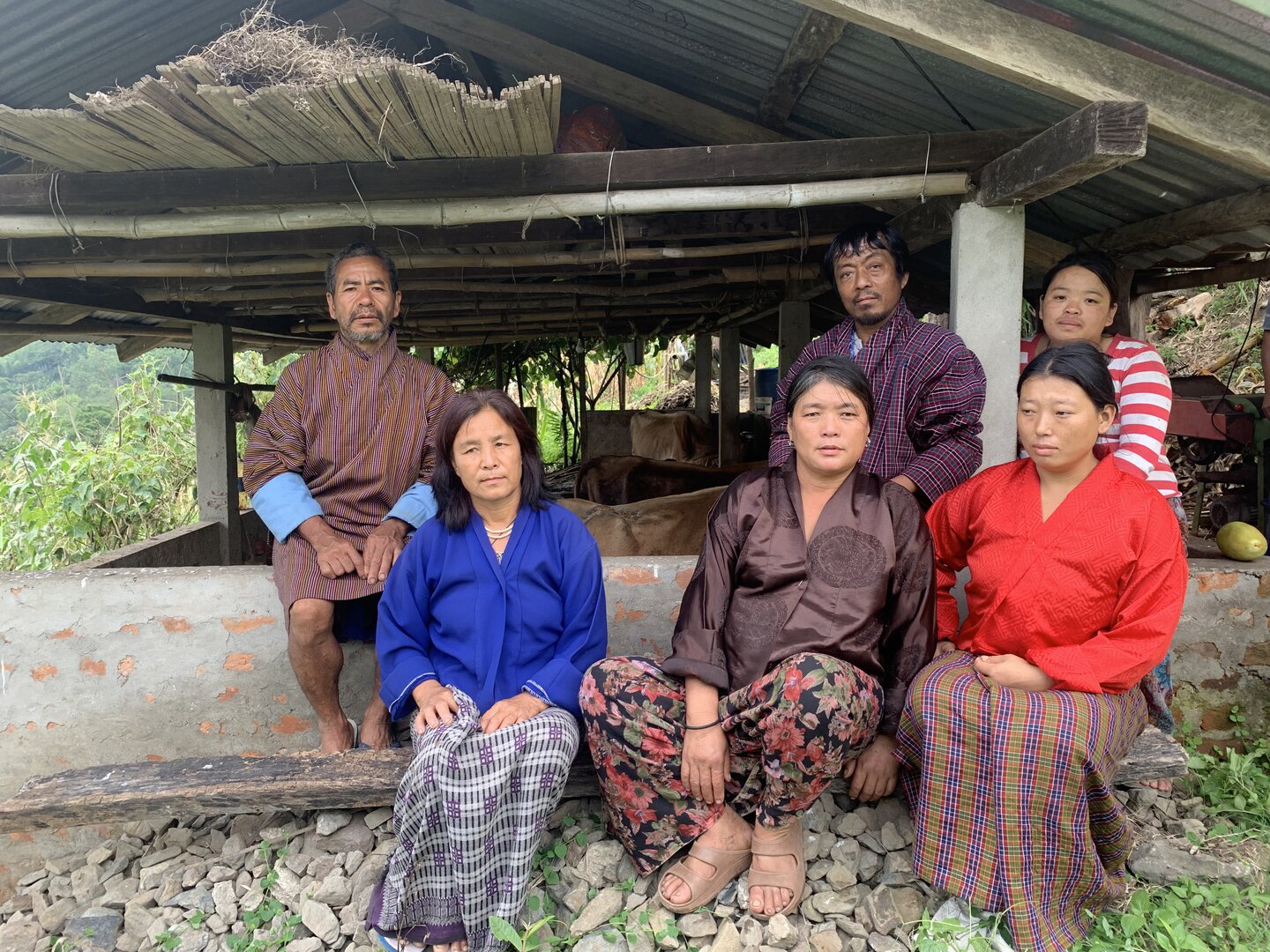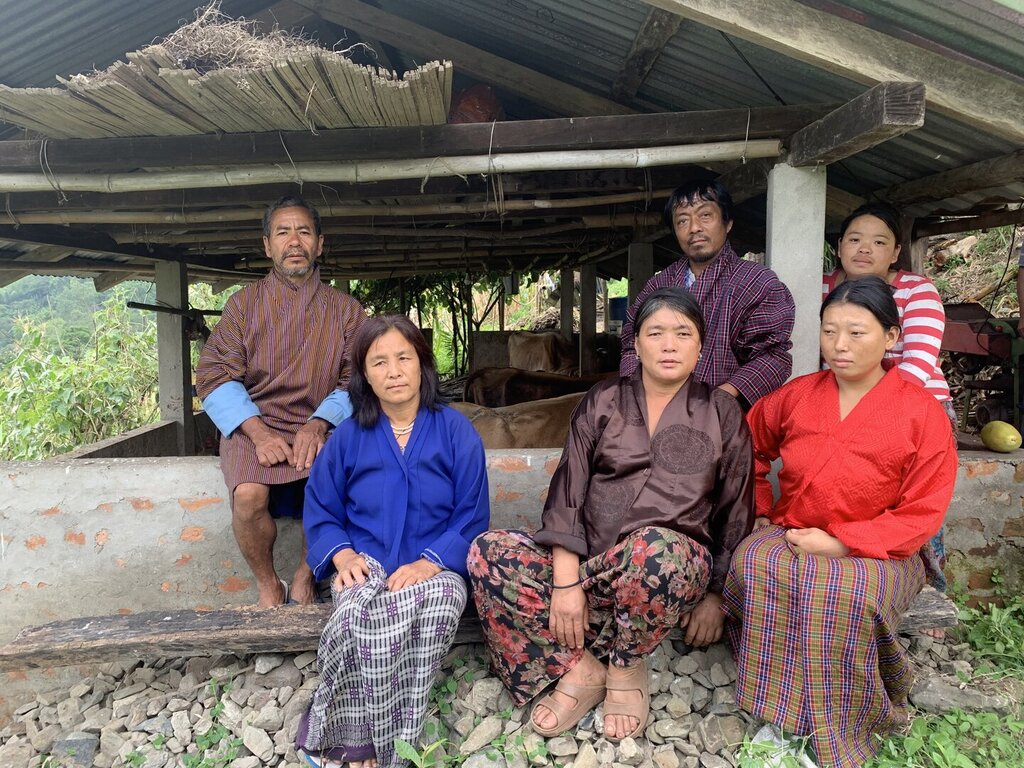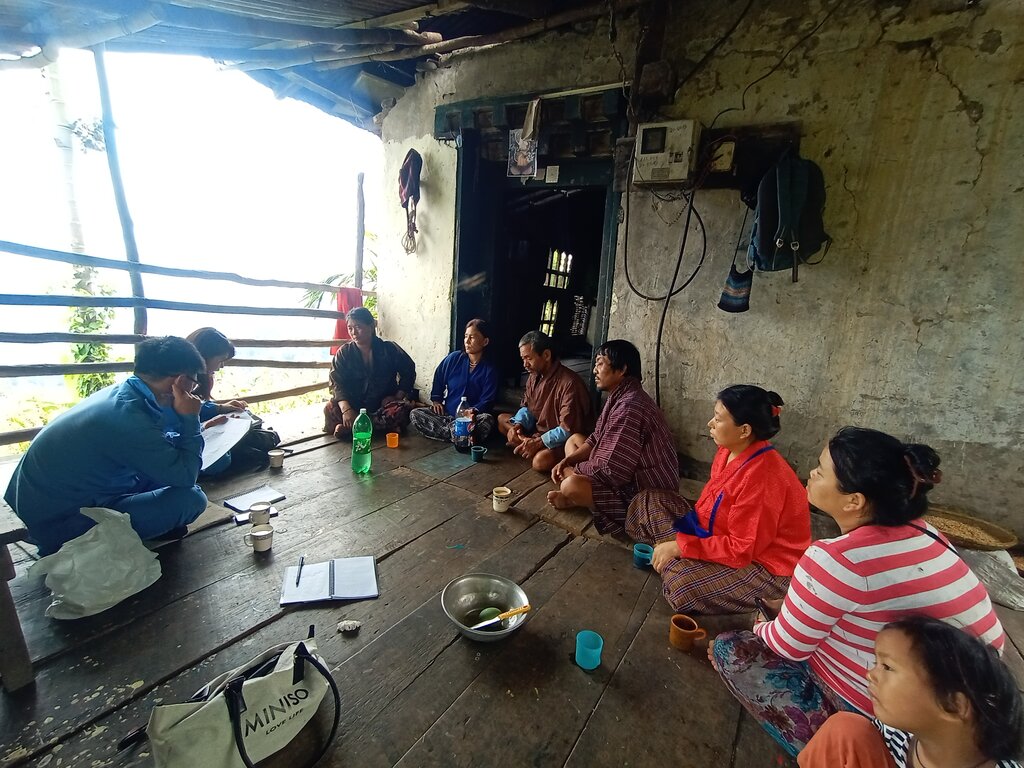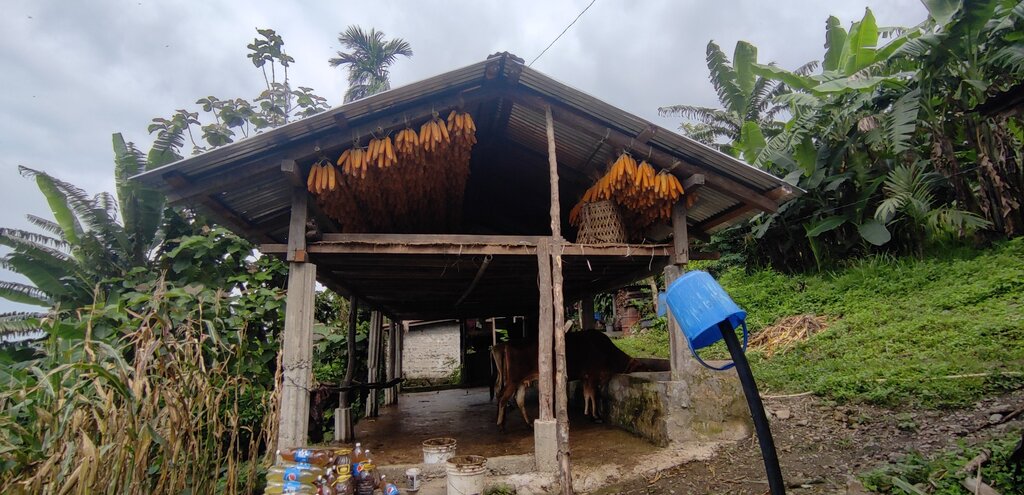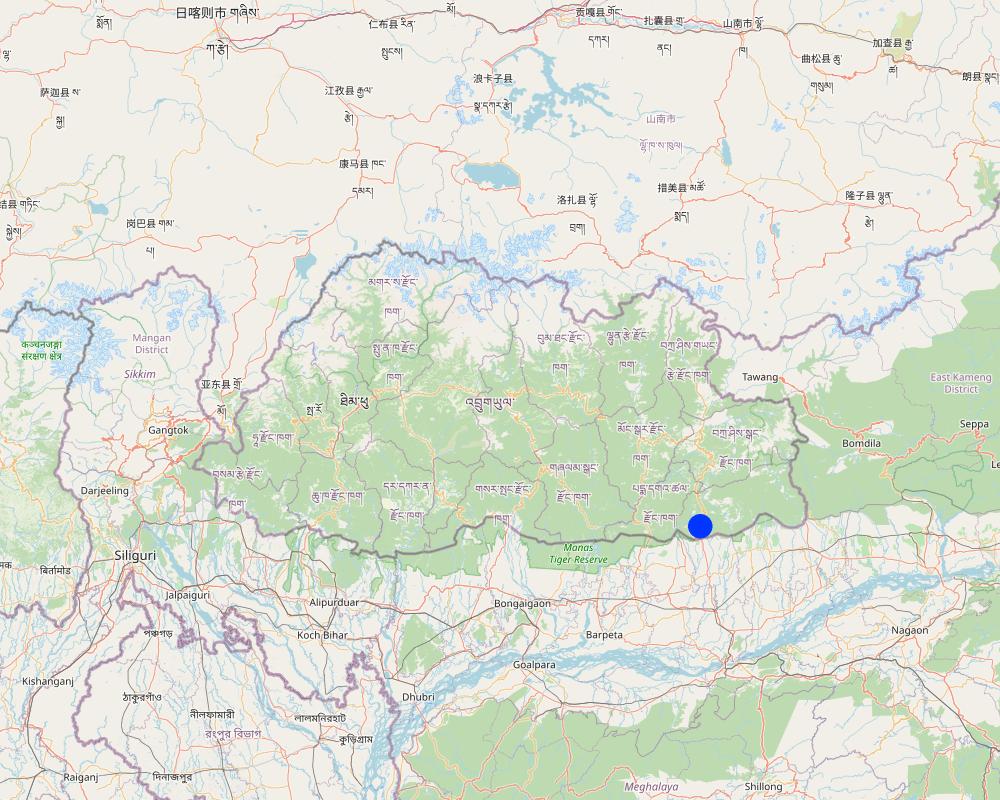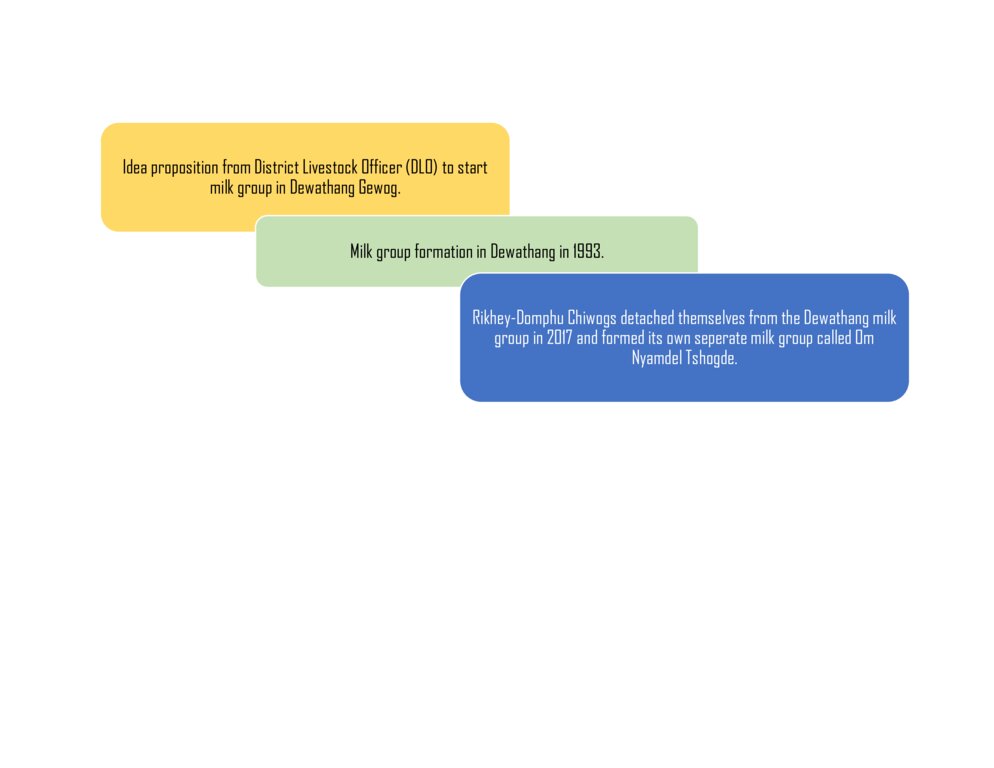Improved Livestock Farming System [Butão]
- Criação:
- Atualização:
- Compilador/a: Tshering Yangzom
- Editor: chenga Tshering
- Revisores: William Critchley, Rima Mekdaschi Studer
approaches_6895 - Butão
Veja as seções
Expandir tudo Recolher tudo1. Informação geral
1.2 Detalhes do contato das pessoas capacitadas e instituições envolvidas na avaliação e documentação da abordagem
Pessoa(s) capacitada(s)
usuário de terra:
Yangzom
17410001
Kheripam village, Domphu chiwog, Dewathang gewog, Samdrup Jongkhar Dzongkhag
Butão
usuário de terra:
Zangmo Tshewang
17967451
Kheripam village, Domphu chiwog, Dewathang gewog, Samdrup Jongkhar Dzongkhag
Butão
usuário de terra:
Wangdi
Kheripam village, Domphu chiwog, Dewathang gewog, Samdrup Jongkhar Dzongkhag
Butão
usuário de terra:
Jampel
17940948
Kheripam village, Domphu chiwog, Dewathang gewog, Samdrup Jongkhar Dzongkhag
Butão
usuário de terra:
Zangmo Tendel
17970719
Kheripam village, Domphu chiwog, Dewathang gewog, Samdrup Jongkhar Dzongkhag
Butão
usuário de terra:
Wangmo Cheki
17569913
Kheripam village, Domphu chiwog, Dewathang gewog, Samdrup Jongkhar Dzongkhag
Butão
Nome do projeto que facilitou a documentação/avaliação da Abordagem (se relevante)
Sustainable Land Management Project, Bhutan (SLMP)Nome da(s) instituição(ões) que facilitou(ram) a documentação/avaliação da Abordagem (se relevante)
National Soil Services Center, Department of Agric (National Soil Services Center, Department of Agric) - Butão1.3 Condições em relação ao uso da informação documentada através de WOCAT
Quando os dados foram compilados (no campo)?
09/07/2023
O/a compilador/a e a(s) pessoa(s) capacitada(s) aceitam as condições relativas ao uso de dados documentados através da WOCAT:
Sim
2. Descrição da abordagem de GST
2.1 Descrição curta da abordagem
The approach involves a group of farmers implementing an improved dairy system. The system incorporates practices and technologies that enhance animal welfare, reduce environmental impact, and increase production.
2.2 Descrição detalhada da abordagem
Descrição detalhada da abordagem:
This case describes how a group approach can facilitate and encourage improved dairy production with better sheds, more productive breeds, environmental sustainability and marketing. Upgraded dairy production is described in detail under the technology “Improved dairy sheds” (T6898).
Initially, the land users were a part of a bigger milk group established in 1993. In 2017, some detached themselves and formed “Om Nyamdel Tshogde” which is a group composed of 67 members from Rikhey and Domphu chiwogs, led by a Chairperson, Mrs. Yangzom. The group also has a treasurer, Drungchen, and a driver. The main objective of forming the milk group was to improve the livelihoods of land users through higher yields via better livestock farming. The group formation process was assisted by the livestock extension officer. The funding was mobilized from the community itself.
The group members, with some support from the government, constructed improved dairy sheds, and biogas plants, and received training on fodder plantations. The stakeholders involved were land users, livestock extension officers, and the private cooperative B-COOP. The land users' role is to coordinate and conduct activities related to livestock farming. The extension officer's role is to provide veterinary and technical services. B-COOP's role is to buy dairy products from the group, especially milk.
The group members have installed improved dairy sheds with cemented floors, feeding troughs, corrugated galvanised iron (CGI) roofing, and a continuous water supply. Also, cattle have access to timely veterinary services. Cow dung and urine are used as fertilizers and also in biogas plants. Biogas plants generate renewable energy (methane), thereby cutting down the use of liquefied petroleum gas (LPG) gas which is derived from fossil fuel.
Under improved dairy sheds, stall-feeding is practised which bars the cattle from going to forests to feed. This prevents the degradation of land by cattle movement through trampling. For better nutrition and feeding, grass fodder species including Super Napier (pakchung), Napier, and Guatemala are grown, cut and and fed to cattle. In addition, other feeds provided included banana stems, maize stems, maize powder, mustard cake, and processed feeds. The group delivers at least 300 litres of milk per day to B-COOP, and some milk goes to India.
Improved breeds have replaced numerous low-yielding local cattle thereby making more efficient use of cattle feed. Also, fewer, more productive animals help reduce environmental degradation and methane losses to the atmosphere. The majority of cattle reared have been bred through artificial insemination. Most cattle are 50:50 hybrids between local breeds and improved breeds such as Jersey. Improving the breeds helps to increase milk production (e.g Holstein Friesian) and or percentage butter fat (e.g. Jersey). To feed and sustain productive, improved breeds, various fodder species are cultivated in large areas. This helps in carbon sequestration and preventing soil erosion.
What the land users like about the approach is that improved livestock farming results in a continuous source of income, as milk production is not seasonal like vegetable production, it provides organic fertilizers for fields, improves livelihoods, makes use of waste such as cow dung in biogas plants which means reduced dependency on LPG gas which is quite expensive. Also access to credit is increased. Government support has increased after the milk group formation. Furthermore, the workload is shared among the land users, especially during the making of biogas plants, thus easing the workload per person.
2.3 Fotos da abordagem
2.4 Vídeos da abordagem
Comentários, breve descrição:
Cattle feeding inside an improved dairy shed
https://youtu.be/ZxV-PbV6UXY
Data:
09/07/2023
Localização:
Kheripam village, Domphu chiwog, Dewathang gewog, Samdrup Jongkhar Dzongkhag
Nome do cinegrafista:
Nima Dolma Tamang
2.5 País/região/locais onde a abordagem foi aplicada
País:
Butão
Região/Estado/Província:
Kheripam village, Domphu chiwog, Dewathang gewog, Samdrup Jongkhar Dzongkhag
Map
×2.6 Datas de início e término da abordagem
Indique o ano de início:
2017
Comentários:
The approach is ongoing with no fixed termination date. The approach shall continue as long as it seems to help the land users.
2.7 Tipo de abordagem
- Iniciativa/inovação local recente
2.8 Principais metas/objetivos da abordagem
The main aims of the approach are to enhance the overall well-being of animals, optimize animal production, minimize forest grazing and promote continuous stall feeding, increase the availability of FYM and urine for application to fields, develop pasture with fodder grasses, foster efficient waste utilization, provide a comfortable working environment for land users, and improve the livelihoods of land users through higher yields and better household income.
2.9 Condição que propiciam ou inibem a implementação de tecnologia/tecnologias aplicada(s) segundo a abordagem
Disponibilidade/acesso a recursos e serviços financeiros
- Propício
There is assured monthly income for the land users due to the supply of milk to B-COOP and India.
Quadro institucional
- Propício
There is assured monthly income for the land users due to the supply of milk and other dairy products to B-COOP and India. This has helped improve the livelihoods of land users through higher yields and better household income.
Colaboração/coordenção de atores
- Propício
There is labour sharing in the group (for example in the construction of biogas plants) thereby easing the workload in the group. The milk group is collectively run by the land users. Every land user is equally involved in meetings related to the group. The land users also share experiences and ideas, resulting in continuous improvement. All these enhance collaboration/coordination among the land users.
Políticas
- Propício
The government has supported the land users by providing deep freezers and other livestock farming construction materials free of cost.
Conhecimento sobre GST, acesso a suporte técnico
- Propício
The land users realize the importance of improved livestock farming systems and biogas plants. They also have access to advisory services from the livestock extension officer.
Mercados (para comprar entradas, vender produtos) e preços
- Propício
The group sells dairy products to Bhutan (B-COOP) and India, especially milk and generates income. The group has access to different markets which might have been difficult for individual farmers to have access to.
Carga de trabalho, disponibilidade de força de trabalho
- Propício
There is labour-sharing in the group (for example in the construction of biogas plants) thereby easing the workload in the group.
3. Participação e papel das partes interessadas envolvidas
3.1 Partes interessadas envolvidas na abordagem e seus papéis
- Usuários de terra/comunidades locais
The land users of Rikhey-Domphu chiwogs.
Collectively produce milk (at least 300 L/day).
- Especialistas em GST/ consultor agrícola
Livestock extension officer.
Provide technical support to land users.
- Setor privado
Bhutan Cooperative (B-COOP)
Buy milk from the group.
3.2 Envolvimento do usuários de terra/comunidades locais nas diferentes fases da abordagem
| Envolvimento do usuários de terra/comunidades locais | Especifique quem estava envolvido e descreva as atividades | |
|---|---|---|
| Iniciação/motivação | Apoio externo | The livestock extension officer proposed the formation of the milk group. |
| Planejamento | Participativo | The livestock officer and land users planned the group management plan. |
| Implementação | Automobilização | The land users carried out the fieldwork of producing milk and constructing improved dairy sheds and biogas plants. |
| Monitoramento/avaliação | Automobilização | The land users monitor their group activities. |
3.3 Fluxograma (se disponível)
3.4 Decisão sobre a seleção de tecnologia/tecnologias de GST
Especifique quem decidiu sobre a seleção de tecnologia/tecnologias a serem implementadas:
- Principalmente usuários da terra, apoiados por especialistas em GST
Explique:
Mainly land users supported by the livestock officer.
Especifique em que base foram tomadas as decisões:
- Avaliação de conhecimento bem documentado de GST (tomada de decisão baseada em evidências)
4. Suporte técnico, reforço das capacidades e gestão do conhecimento
4.1 Reforço das capacidades/ formação
Foi oferecida formação aos usuários da terra/outras partes interessadas?
Sim
Especifique quem foi capacitado:
- Usuários de terra
Caso seja relevante, especifique gênero, idade, status, etnia, etc.
Both male and female.
Tipo de formação:
- Agricultor para agricultor
- Áreas de demonstração
- Reuniões públicas
Assuntos abordados:
-Biogas plant construction
-Fodder grass plantation
4.2 Serviço de consultoria
Os usuários de terra têm acesso a um serviço de consultoria?
Sim
Especifique se foi oferecido serviço de consultoria:
- nas áreas dos usuários da terra
- Em centros permanentes
Descreva/comentários:
The land users have access to advisory services from the livestock extension agent.
4.3 Fortalecimento da instituição (desenvolvimento organizacional)
As instituições foram fortalecidas ou estabelecidas através da abordagem?
- Sim, significativamente
Especifique a que nível (níveis) as instituições foram fortalecidas ou estabelecidas:
- Local
Descreva instituição, papéis e responsabilidades, membros, etc.
There is assured monthly income for the land users due to the sell of milk and other dairy products such as cheese and butter.
Especifique o tipo de apoio:
- Financeiro
4.4 Monitoramento e avaliação
Monitoramento e avaliação são partes da abordagem?
Sim
Caso afirmativo, esta documentação é destinada a ser utilizada para monitoramento e avaliação?
Não
4.5 Pesquisa
A pesquisa foi parte da abordagem?
Não
5. Financiamento e apoio material externo
5.1 Orçamento anual para o componente de GST da abordagem
Caso o orçamento exato seja desconhecido, indique a faixa:
- < 2.000
Comentários (p. ex. principais fontes de recursos/principais doadores):
There is no annual budget allocated for the construction of improved dairy sheds and biogas plants. For biogas plant construction, pipes, metals, and 15 bags of cement were provided to land users by the government. For dairy shed construction, roofing material (18 CGI sheets) and 18 bags of cement were provided. These materials were provided by the government only once. There is no annual providing of materials or money to the land users.
5.2 Apoio financeiro/material concedido aos usuários da terra
Os usuários da terra receberam apoio financeiro/material para a implementação de tecnologia/tecnologias?
Sim
Caso afirmativo, especifique tipo(s) de apoio, condições e fornecedor(es):
For biogas plant construction, pipes, metals, and 15 bags of cement were provided to land users by the government. For dairy shed construction, roofing material (18 CGI sheets) and 18 bags of cement were provided. Also, deep freezers were provided to the land users.
5.3 Subsídios para entradas específicas (incluindo mão-de-obra)
- Equipamento
| Especifique quais entradas foram subsidiadas | Em que medida | Especifique os subsídios |
|---|---|---|
| Totalmente financiado | Deep freezers | |
- Construção
| Especifique quais entradas foram subsidiadas | Em que medida | Especifique os subsídios |
|---|---|---|
| Parcialmente financiado | Cement bags CGI sheets Pipes Metals A part of these materials was financed by the government. | |
Se a mão-de-obra pelos usuários da terra foi uma entrada substancial, isso foi:
- Voluntário
5.4 Crédito
Foi concedido crédito segundo a abordagem para atividades de GST?
Sim
Especifique as condições (taxa de juros, reembolso, etc):
Nu 20,000 credit
Especifique os fornecedores de crédito:
BDBL
Especifique os destinatários do crédito:
Land users
5.5 Outros incentivos ou instrumentos
Foram utilizados outros incentivos ou instrumentos para promover a implementação das tecnologias de GST?
Não
6. Análise de impactos e declarações finais
6.1 Impactos da abordagem
There is assured monthly income for the land users due to the sale of milk and this has empowered them to produce more milk to earn more money. There is labour sharing in the group (for example in the construction of biogas plants) thereby easing the workload in the group. The milk group is collectively run by the land users. Every land user is equally involved in meetings related to the group. The land users also share experiences and ideas, resulting in continuous improvement. All these enhance collaboration/coordination among the land users (stakeholders).
There is assured monthly income for the land users due to the sale of milk and this has enabled the land users to continue with stall feeding practices and pasture establishment to produce more milk to earn more money.
A abordagem auxiliou os usuários da terra a implementar e manter as tecnologias de GST?
- Não
- Sim, pouco
- Sim, moderadamente
- Sim, significativamente
Improved livestock farming system has promoted technologies such as improved dairy sheds and biogas plants.
A abordagem aprimorou o conhecimento e as capacidades dos usuários da terra para implementar a GST?
- Não
- Sim, pouco
- Sim, moderadamente
- Sim, significativamente
The land users have adopted technologies such as improved dairy sheds and biogas plants.
A abordagem construiu/fortaleceu instituições, colaboração entre partes interessadas?
- Não
- Sim, pouco
- Sim, moderadamente
- Sim, significativamente
The land users have been able to sell milk and other dairy products to B-COOP and India and this has helped the land users generate income. Also, B-COOP and India have benefitted from the continuous milk supply from the milk group. The milk group has helped in forming a partnership between the land users and the buyers.
A abordagem atenuou conflitos?
- Não
- Sim, pouco
- Sim, moderadamente
- Sim, significativamente
The land users have developed pasture land of Super Napier, Napier, and Guatemala grasses for stall feeding of cattle. This has minimized the issue of cattle entering other land users' fields and foraging on the crops.
A abordagem concedeu autonomia aos grupos social e economicamente desfavorecidos?
- Não
- Sim, pouco
- Sim, moderadamente
- Sim, significativamente
Land users from different backgrounds are now part of the milk group.
A abordagem melhorou a igualdade de gêneros e concedeu autonomia a mulheres e meninas?
- Não
- Sim, pouco
- Sim, moderadamente
- Sim, significativamente
Land users in the milk group are a mix of males and females. There is no gender discrimination.
A abordagem resultou em segurança alimentar aprimorada/nutrição melhorada?
- Não
- Sim, pouco
- Sim, moderadamente
- Sim, significativamente
Land users have assured monthly income due to the sale of milk and other dairy products. This has led to better household income. Also, stall feeding under an improved dairy shed has promoted the cultivation of fodder of good quality and variety leading to increased and quality milk production.
A abordagem melhorou o acesso aos mercados?
- Não
- Sim, pouco
- Sim, moderadamente
- Sim, significativamente
Land users now sell milk and other dairy products to B-COOP and India.
A abordagem resultou em uso/fontes de energia mais sustentável?
- Não
- Sim, pouco
- Sim, moderadamente
- Sim, significativamente
Biogas plants have reduced the use of LPG in some households.
A abordagem resultou em emprego, oportunidades de renda?
- Não
- Sim, pouco
- Sim, moderadamente
- Sim, significativamente
Group marketing has helped land users earn better.
6.2 Principal motivação dos usuários da terra para implementar a GST
- Produção aumentada
The improved dairy shed has improved the quality and quantity of milk.
- Lucro (lucrabilidade) aumentado, melhora da relação custo-benefício
There is assured monthly income for the land users.
- Degradação do solo reduzida
Application of FYM to the field results in an increase in organic matter and an increase in nutrient availability in fields. There is better soil water retention by an increase in soil organic matter. Cattle urine also adds nutrients to the soil. Stall feeding under an improved dairy shed promotes the cultivation of fodder of good quality and variety. This helps maintain vegetative cover and prevent degradation of arable land. Similarly, stall feeding using crop residues from the field helps maintain vegetative cover and prevent the degradation of arable land. The land users feed fodder grasses such as Super Napier and Napier that help stabilize soil and provide ground cover. Other feeds provided to cattle include banana stems, mustard cakes, straw, Guatemala grass, and processed feeds (Karma Feeds). The use of organic fertilizers such as cow dung and urine minimizes the need for chemical fertilisers that can cause loss of beneficial soil organisms, reduced organic matter, soil acidification, and nutrient imbalances in the soil.
- melhoria dos conhecimentos e aptidões de GST
-Construction of improved dairy sheds
-Construction of biogas plants
6.3 Atividades de sustentabilidade de abordagem
Os usuários da terra podem manter o que foi implementado através da abordagem (sem apoio externo)?
- Não
Caso negativo ou incerto, especifique e comente:
-Improved dairy shed and biogas plant structures if damaged would incur some amount on restoration. They have to be maintained over the years. The cost of maintenance is borne by the land users. The land users do not deliberately save money for the restoration but are well aware of the fact that they will have to spend some amount on the maintenance and restoration whenever need be.
6.4 Pontos fortes/vantagens da abordagem
| Pontos fortes/vantagens/oportunidades na visão do usuário da terra |
|---|
| Government support especially to groups. |
| Easy access to market because of group formation. |
| Improved livelihood of farmers through higher farm yields and better household income. |
| Use of a renewable of energy like biogas instead of LPG. |
| Improved health and animal welfare. |
| Pontos fortes/vantagens/oportunidades na visão do/a compilador/a ou de outra pessoa capacitada |
|---|
| Knowledge sharing (land users can share their ideas and experiences while working in a group). |
| Improved dairy shed made of cement, gravel, and stones is more durable than the old dairy shed made from wood. |
| Availability of good quality fodder and a diverse range of forage options. |
| Increase in organic matter due to FYM application and better soil moisture retention by increased soil organic matter. |
| Reduced labour due to reduced fodder collection and herding in the forest. |
| Efficient waste utilization. |
| Reduced land degradation due to reduction in forest grazing. |
| Increased vegetation cover due to improved pasture development and reduction in forest grazing. |
| Less soil compaction through decreased trampling by animals. |
| Comfortable working environment for land users. |
6.5 Pontos fracos, desvantagens da tecnologia e formas de superá-los
| Pontos fracos/vantagens/riscos na visão do/a compilador/a ou de outra pessoa capacitada | Como eles podem ser superados? |
|---|---|
| Sometimes working in a group can be difficult. Internal conflicts and misunderstanding are common in group ventures. | Regular group meetings and guidance by extension staff. |
7. Referências e links
7.1 Métodos/fontes de informação
- visitas de campo, pesquisas de campo
6
- entrevistas com usuários de terras
6
7.2 Referências às publicações disponíveis
Título, autor, ano, ISBN:
Thapa, L., Choden, D., & Tamang, N. B. (2019). Adoption of Improved Dairy Production Practices by Dairy and Non-Dairy Farmers’ Groups.
Disponível de onde? Custos?
https://www.researchgate.net/profile/Lokey-Thapa/publication/334507972_Adoption_of_Improved_Dairy_Production_Practices_by_Dairy_and_Non-_Dairy_Farmers'_Groups/links/5d2ec146299bf1547cbd248a/Adoption-of-Improved-Dairy-Production-Practices-by-Dairy-and-Non-Dairy-Farmers-Groups.pdf
Links e módulos
Expandir tudo Recolher tudoLinks
Não há links
Módulos
Não há módulos


